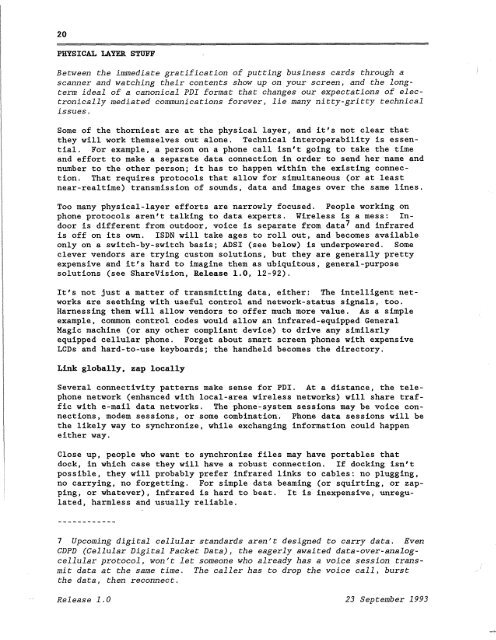23 September 1993 - Cdn.oreilly.com
23 September 1993 - Cdn.oreilly.com
23 September 1993 - Cdn.oreilly.com
Create successful ePaper yourself
Turn your PDF publications into a flip-book with our unique Google optimized e-Paper software.
20<br />
PHYSICAL LAYER STUFF<br />
Between the immediate gratification of putting business cards through a<br />
scanner and watching their contents show up on your screen, and the longterm<br />
ideal of a canonical PDI format that changes our expectations of electronically<br />
mediated <strong>com</strong>munications forever, lie many nitty-gritty technical<br />
issues.<br />
Some of the thorniest are at the physical layer, and it's not clear that<br />
they will work themselves out alone. Technical interoperability is essential.<br />
For example, a person on a phone call isn't going to take the time<br />
and effort to make a separate data connection in order to send her name and<br />
number to the other person; it has to happen within the existing connection.<br />
That requires protocols that allow for simultaneous (or at least<br />
near-realtime) transmission of sounds, data and images over the same lines.<br />
Too many physical-layer efforts are narrowly focused. People working on<br />
phone protocols aren't talking to data experts. Wireless is a mess: Indoor<br />
is different from outdoor, voice is separate from data 7 and infrared<br />
is off on its own. ISDN will take ages to roll out, and be<strong>com</strong>es available<br />
only on a switch-by-switch basis; ADSI (see below) is underpowered. Some<br />
clever vendors are trying custom solutions, but they are generally pretty<br />
expensive and it's hard to imagine them as ubiquitous, general-purpose<br />
solutions (see ShareVision, Release 1.0, 12-92).<br />
It's not just a matter of transmitting data, either: The intelligent networks<br />
are seething with useful control and network-status signals, too.<br />
Harnessing them will allow vendors to offer much more value. As a simple<br />
example, <strong>com</strong>mon control codes would allow an infrared-equipped General<br />
Magic machine (or any other <strong>com</strong>pliant device) to drive any similarly<br />
equipped cellular phone. Forget about smart screen phones with expensive<br />
LCDs and hard-to-use keyboards; the handheld be<strong>com</strong>es the directory.<br />
Link globally, zap locally<br />
Several connectivity patterns make sense for PDI. At a distance, the telephone<br />
network (enhanced with local-area wireless networks) will share traffic<br />
with e-mail data networks. The phone-system sessions may be voice connections,<br />
modem sessions, or some <strong>com</strong>bination. Phone data sessions will be<br />
the likely way to synchronize, while exchanging information could happen<br />
either way.<br />
Close up, people who want to synchronize files may have portables that<br />
dock, in which case they will have a robust connection. If docking isn't<br />
possible, they will probably prefer infrared links to cables: no plugging,<br />
no carrying, no forgetting. For simple data beaming (or squirting, or zapping,<br />
or whatever), infrared is hard to beat. It is inexpensive, unregulated,<br />
harmless and usually reliable.<br />
7 Up<strong>com</strong>ing digital cellular standards aren't designed to carry data. Even<br />
CDPD (Cellular Digital Packet Data), the eagerly awaited data-over-analogcellular<br />
protocol, won't let someone who already has a voice session transmit<br />
data at the same time. The caller has to drop the voice call, burst<br />
the data, then reconnect.<br />
Release 1.0 <strong>23</strong> <strong>September</strong> <strong>1993</strong>

















